Project Feasibility Study and Timeline: Residential Duplex in Bendigo
VerifiedAdded on 2022/12/23
|12
|3030
|5
Report
AI Summary
This report presents a feasibility study for a residential duplex construction project in Bendigo, Victoria, Australia, with a budget of $800,000 and a nine-month timeframe. The study analyzes various factors, including land information, purchase details, local council regulations, construction costs, and duplex information. It assesses the project's feasibility by considering factors such as planning permission, legal approvals, budget constraints, environmental reflections, and operational/maintenance issues. The report also addresses project constraints like location, budget, and time, alongside project goals such as selecting appropriate land, obtaining council permissions, and completing the project within budget and time. Economic considerations, including costs for planning, labor, materials, and transportation, are also evaluated. The study further examines macro-environment business drivers (economic, competitive, resourcing, and demographic factors) and micro-environment business drivers (technical expertise, time pressure, and people-related considerations). Ultimately, the report provides a comprehensive overview of the project's viability and potential challenges.
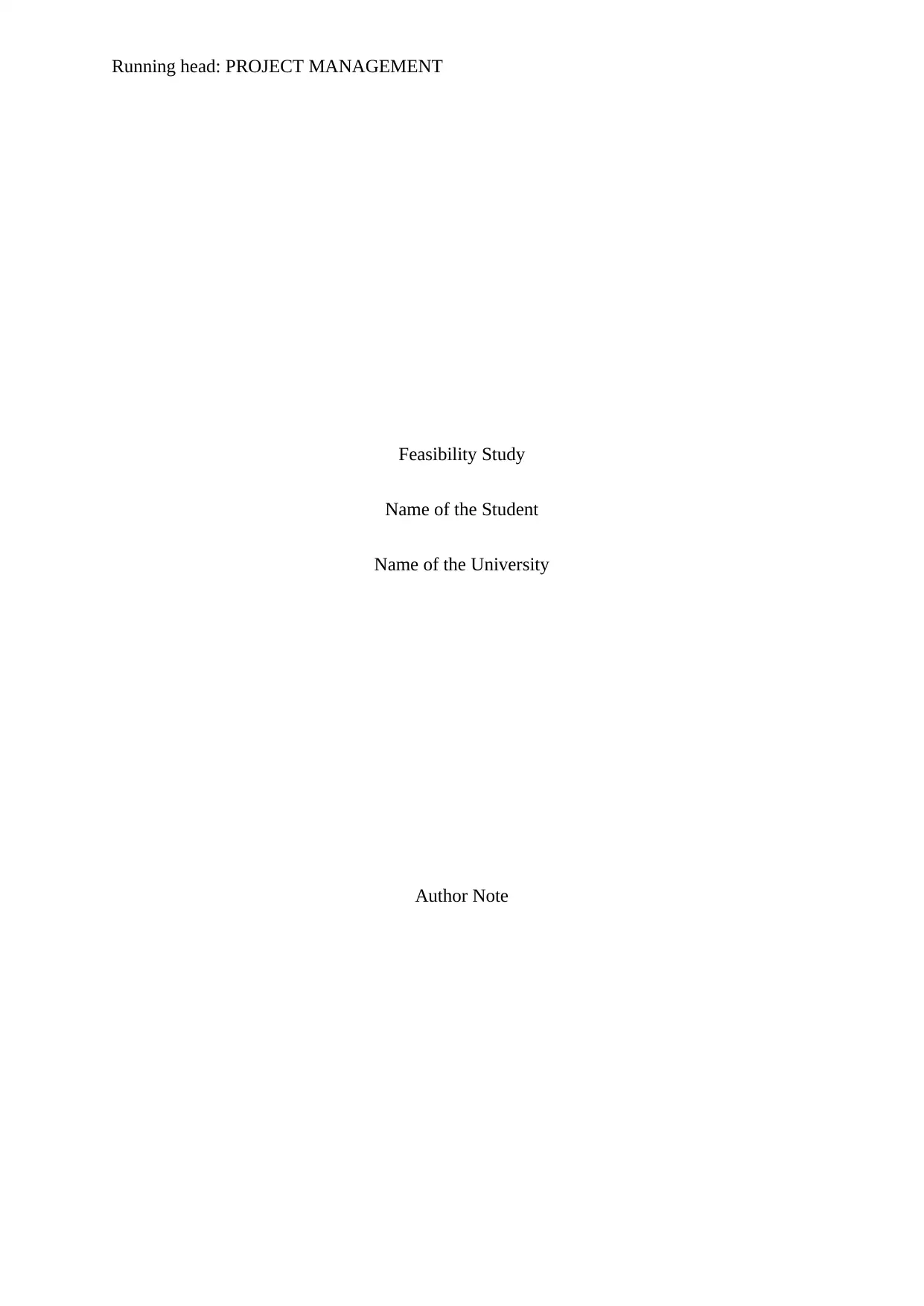
Running head: PROJECT MANAGEMENT
Feasibility Study
Name of the Student
Name of the University
Author Note
Feasibility Study
Name of the Student
Name of the University
Author Note
Paraphrase This Document
Need a fresh take? Get an instant paraphrase of this document with our AI Paraphraser
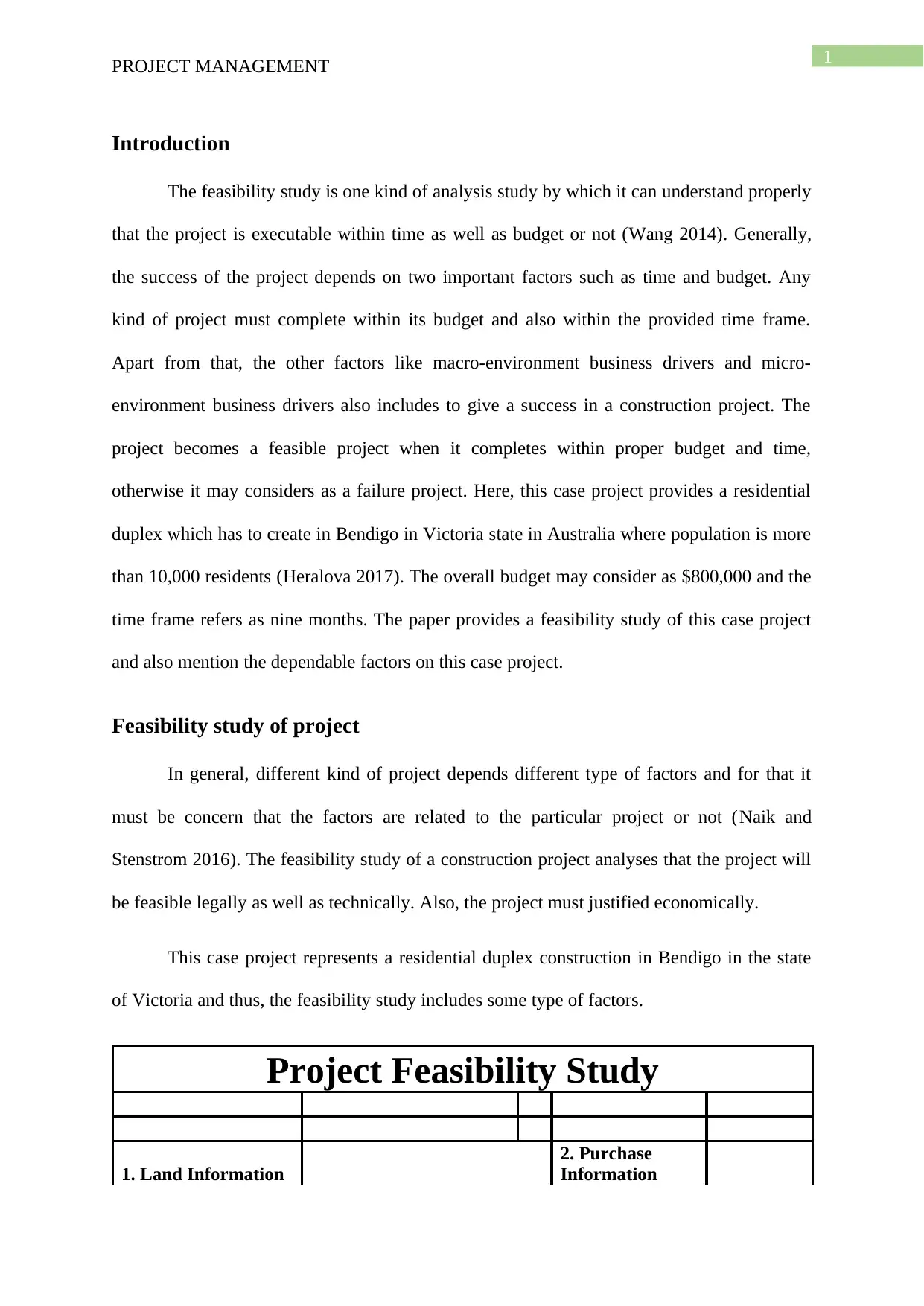
1
PROJECT MANAGEMENT
Introduction
The feasibility study is one kind of analysis study by which it can understand properly
that the project is executable within time as well as budget or not (Wang 2014). Generally,
the success of the project depends on two important factors such as time and budget. Any
kind of project must complete within its budget and also within the provided time frame.
Apart from that, the other factors like macro-environment business drivers and micro-
environment business drivers also includes to give a success in a construction project. The
project becomes a feasible project when it completes within proper budget and time,
otherwise it may considers as a failure project. Here, this case project provides a residential
duplex which has to create in Bendigo in Victoria state in Australia where population is more
than 10,000 residents (Heralova 2017). The overall budget may consider as $800,000 and the
time frame refers as nine months. The paper provides a feasibility study of this case project
and also mention the dependable factors on this case project.
Feasibility study of project
In general, different kind of project depends different type of factors and for that it
must be concern that the factors are related to the particular project or not (Naik and
Stenstrom 2016). The feasibility study of a construction project analyses that the project will
be feasible legally as well as technically. Also, the project must justified economically.
This case project represents a residential duplex construction in Bendigo in the state
of Victoria and thus, the feasibility study includes some type of factors.
Project Feasibility Study
1. Land Information
2. Purchase
Information
PROJECT MANAGEMENT
Introduction
The feasibility study is one kind of analysis study by which it can understand properly
that the project is executable within time as well as budget or not (Wang 2014). Generally,
the success of the project depends on two important factors such as time and budget. Any
kind of project must complete within its budget and also within the provided time frame.
Apart from that, the other factors like macro-environment business drivers and micro-
environment business drivers also includes to give a success in a construction project. The
project becomes a feasible project when it completes within proper budget and time,
otherwise it may considers as a failure project. Here, this case project provides a residential
duplex which has to create in Bendigo in Victoria state in Australia where population is more
than 10,000 residents (Heralova 2017). The overall budget may consider as $800,000 and the
time frame refers as nine months. The paper provides a feasibility study of this case project
and also mention the dependable factors on this case project.
Feasibility study of project
In general, different kind of project depends different type of factors and for that it
must be concern that the factors are related to the particular project or not (Naik and
Stenstrom 2016). The feasibility study of a construction project analyses that the project will
be feasible legally as well as technically. Also, the project must justified economically.
This case project represents a residential duplex construction in Bendigo in the state
of Victoria and thus, the feasibility study includes some type of factors.
Project Feasibility Study
1. Land Information
2. Purchase
Information
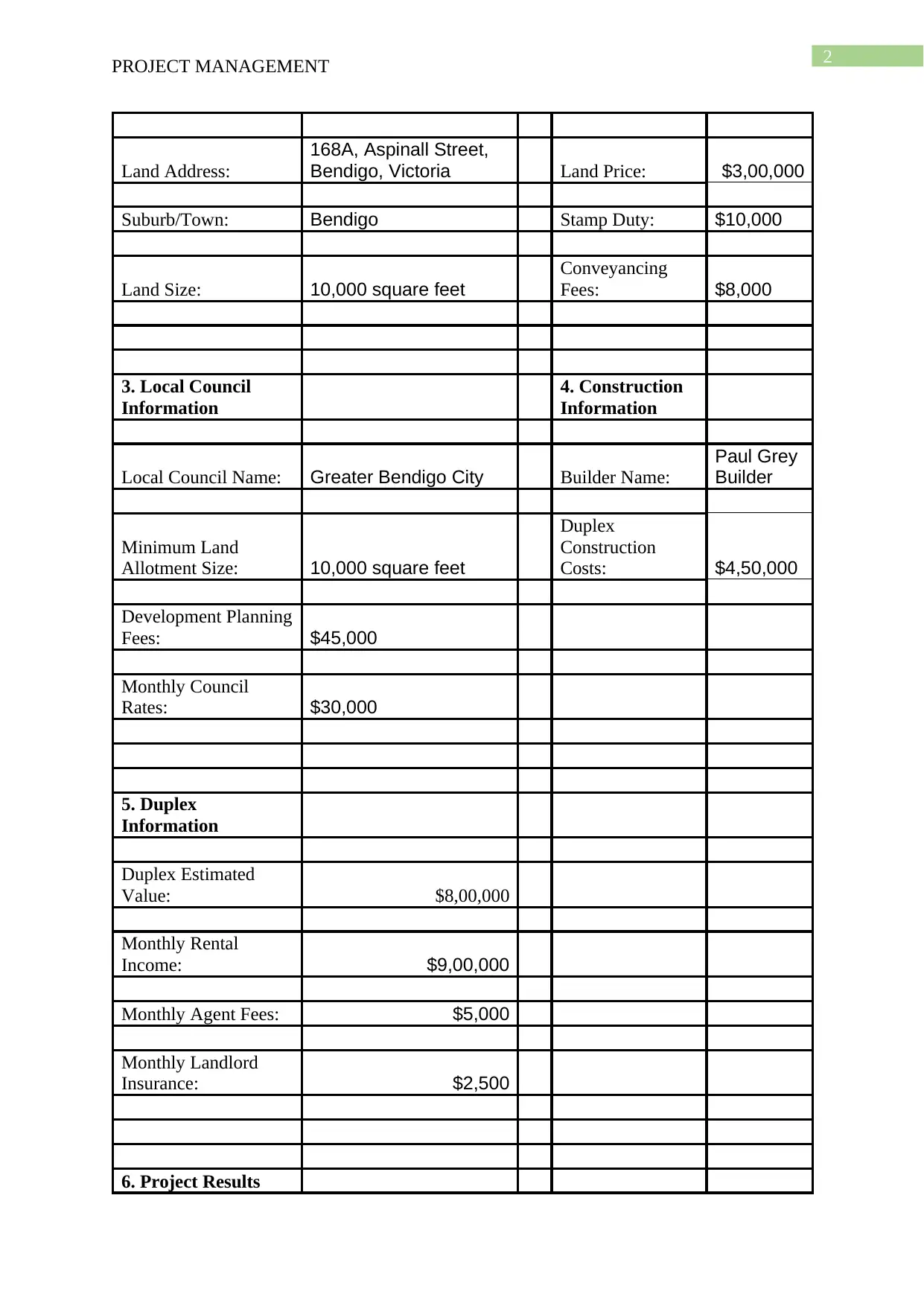
2
PROJECT MANAGEMENT
Land Address:
168A, Aspinall Street,
Bendigo, Victoria Land Price: $3,00,000
Suburb/Town: Bendigo Stamp Duty: $10,000
Land Size: 10,000 square feet
Conveyancing
Fees: $8,000
3. Local Council
Information
4. Construction
Information
Local Council Name: Greater Bendigo City Builder Name:
Paul Grey
Builder
Minimum Land
Allotment Size: 10,000 square feet
Duplex
Construction
Costs: $4,50,000
Development Planning
Fees: $45,000
Monthly Council
Rates: $30,000
5. Duplex
Information
Duplex Estimated
Value: $8,00,000
Monthly Rental
Income: $9,00,000
Monthly Agent Fees: $5,000
Monthly Landlord
Insurance: $2,500
6. Project Results
PROJECT MANAGEMENT
Land Address:
168A, Aspinall Street,
Bendigo, Victoria Land Price: $3,00,000
Suburb/Town: Bendigo Stamp Duty: $10,000
Land Size: 10,000 square feet
Conveyancing
Fees: $8,000
3. Local Council
Information
4. Construction
Information
Local Council Name: Greater Bendigo City Builder Name:
Paul Grey
Builder
Minimum Land
Allotment Size: 10,000 square feet
Duplex
Construction
Costs: $4,50,000
Development Planning
Fees: $45,000
Monthly Council
Rates: $30,000
5. Duplex
Information
Duplex Estimated
Value: $8,00,000
Monthly Rental
Income: $9,00,000
Monthly Agent Fees: $5,000
Monthly Landlord
Insurance: $2,500
6. Project Results
⊘ This is a preview!⊘
Do you want full access?
Subscribe today to unlock all pages.

Trusted by 1+ million students worldwide
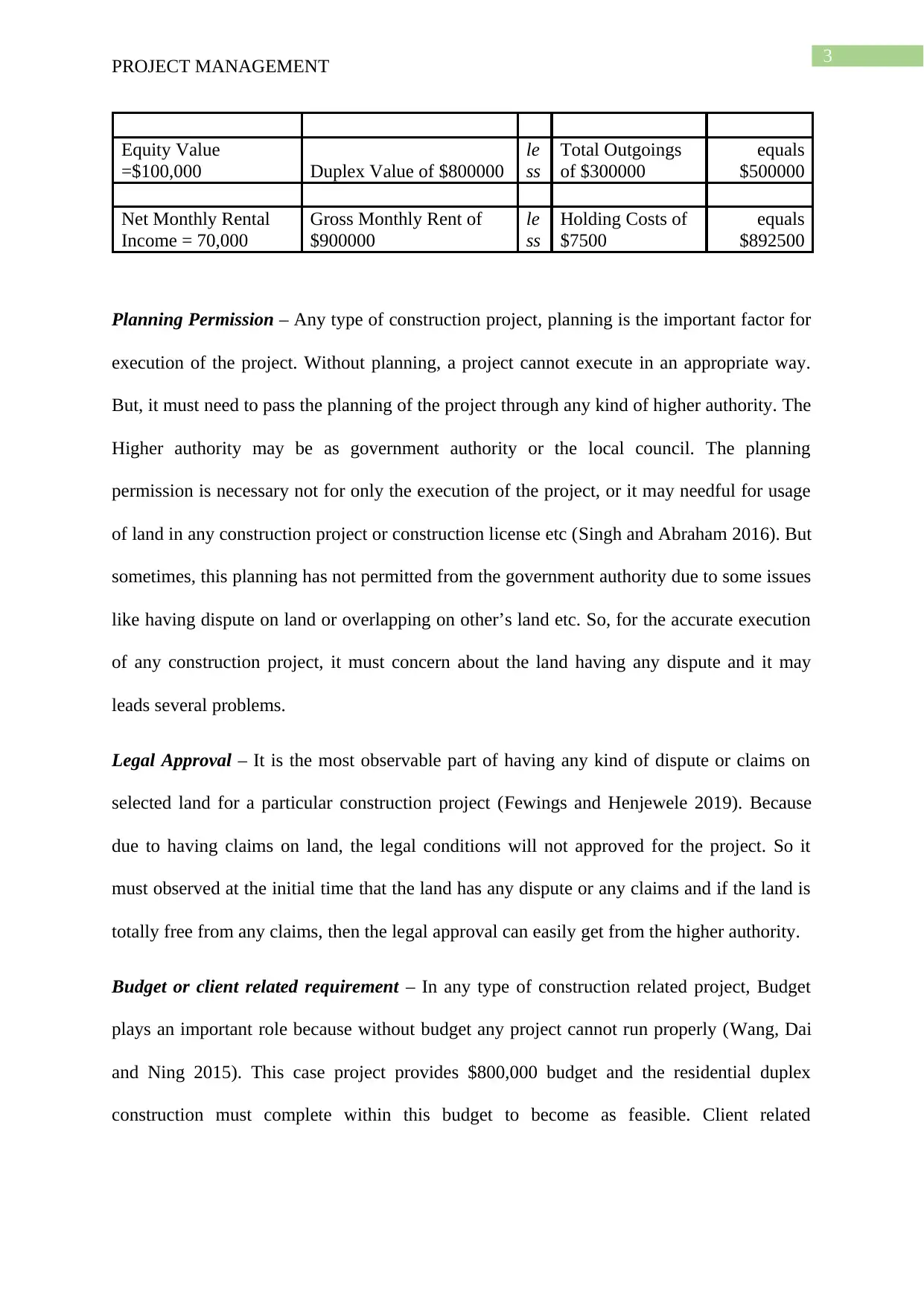
3
PROJECT MANAGEMENT
Equity Value
=$100,000 Duplex Value of $800000
le
ss
Total Outgoings
of $300000
equals
$500000
Net Monthly Rental
Income = 70,000
Gross Monthly Rent of
$900000
le
ss
Holding Costs of
$7500
equals
$892500
Planning Permission – Any type of construction project, planning is the important factor for
execution of the project. Without planning, a project cannot execute in an appropriate way.
But, it must need to pass the planning of the project through any kind of higher authority. The
Higher authority may be as government authority or the local council. The planning
permission is necessary not for only the execution of the project, or it may needful for usage
of land in any construction project or construction license etc (Singh and Abraham 2016). But
sometimes, this planning has not permitted from the government authority due to some issues
like having dispute on land or overlapping on other’s land etc. So, for the accurate execution
of any construction project, it must concern about the land having any dispute and it may
leads several problems.
Legal Approval – It is the most observable part of having any kind of dispute or claims on
selected land for a particular construction project (Fewings and Henjewele 2019). Because
due to having claims on land, the legal conditions will not approved for the project. So it
must observed at the initial time that the land has any dispute or any claims and if the land is
totally free from any claims, then the legal approval can easily get from the higher authority.
Budget or client related requirement – In any type of construction related project, Budget
plays an important role because without budget any project cannot run properly (Wang, Dai
and Ning 2015). This case project provides $800,000 budget and the residential duplex
construction must complete within this budget to become as feasible. Client related
PROJECT MANAGEMENT
Equity Value
=$100,000 Duplex Value of $800000
le
ss
Total Outgoings
of $300000
equals
$500000
Net Monthly Rental
Income = 70,000
Gross Monthly Rent of
$900000
le
ss
Holding Costs of
$7500
equals
$892500
Planning Permission – Any type of construction project, planning is the important factor for
execution of the project. Without planning, a project cannot execute in an appropriate way.
But, it must need to pass the planning of the project through any kind of higher authority. The
Higher authority may be as government authority or the local council. The planning
permission is necessary not for only the execution of the project, or it may needful for usage
of land in any construction project or construction license etc (Singh and Abraham 2016). But
sometimes, this planning has not permitted from the government authority due to some issues
like having dispute on land or overlapping on other’s land etc. So, for the accurate execution
of any construction project, it must concern about the land having any dispute and it may
leads several problems.
Legal Approval – It is the most observable part of having any kind of dispute or claims on
selected land for a particular construction project (Fewings and Henjewele 2019). Because
due to having claims on land, the legal conditions will not approved for the project. So it
must observed at the initial time that the land has any dispute or any claims and if the land is
totally free from any claims, then the legal approval can easily get from the higher authority.
Budget or client related requirement – In any type of construction related project, Budget
plays an important role because without budget any project cannot run properly (Wang, Dai
and Ning 2015). This case project provides $800,000 budget and the residential duplex
construction must complete within this budget to become as feasible. Client related
Paraphrase This Document
Need a fresh take? Get an instant paraphrase of this document with our AI Paraphraser
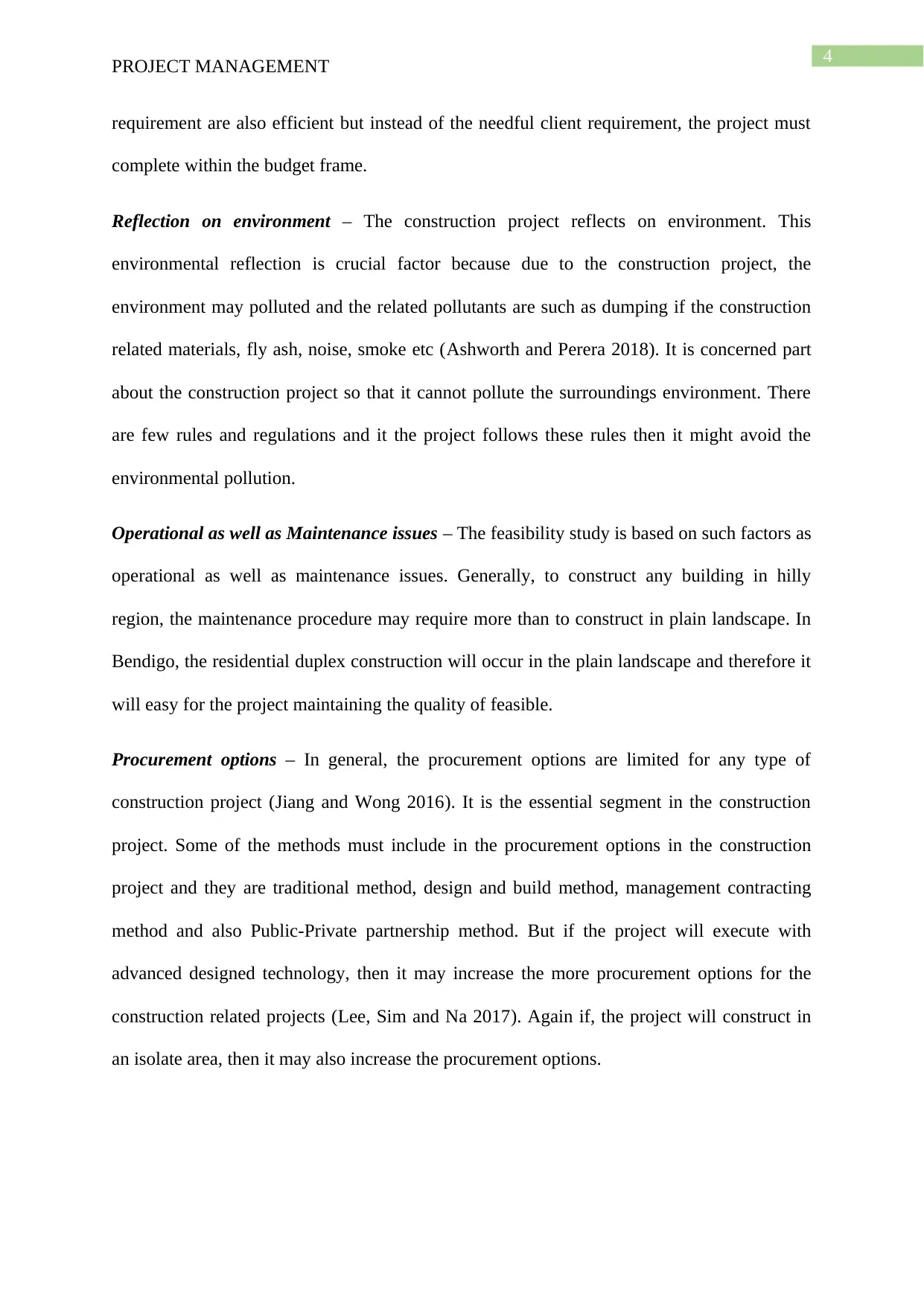
4
PROJECT MANAGEMENT
requirement are also efficient but instead of the needful client requirement, the project must
complete within the budget frame.
Reflection on environment – The construction project reflects on environment. This
environmental reflection is crucial factor because due to the construction project, the
environment may polluted and the related pollutants are such as dumping if the construction
related materials, fly ash, noise, smoke etc (Ashworth and Perera 2018). It is concerned part
about the construction project so that it cannot pollute the surroundings environment. There
are few rules and regulations and it the project follows these rules then it might avoid the
environmental pollution.
Operational as well as Maintenance issues – The feasibility study is based on such factors as
operational as well as maintenance issues. Generally, to construct any building in hilly
region, the maintenance procedure may require more than to construct in plain landscape. In
Bendigo, the residential duplex construction will occur in the plain landscape and therefore it
will easy for the project maintaining the quality of feasible.
Procurement options – In general, the procurement options are limited for any type of
construction project (Jiang and Wong 2016). It is the essential segment in the construction
project. Some of the methods must include in the procurement options in the construction
project and they are traditional method, design and build method, management contracting
method and also Public-Private partnership method. But if the project will execute with
advanced designed technology, then it may increase the more procurement options for the
construction related projects (Lee, Sim and Na 2017). Again if, the project will construct in
an isolate area, then it may also increase the procurement options.
PROJECT MANAGEMENT
requirement are also efficient but instead of the needful client requirement, the project must
complete within the budget frame.
Reflection on environment – The construction project reflects on environment. This
environmental reflection is crucial factor because due to the construction project, the
environment may polluted and the related pollutants are such as dumping if the construction
related materials, fly ash, noise, smoke etc (Ashworth and Perera 2018). It is concerned part
about the construction project so that it cannot pollute the surroundings environment. There
are few rules and regulations and it the project follows these rules then it might avoid the
environmental pollution.
Operational as well as Maintenance issues – The feasibility study is based on such factors as
operational as well as maintenance issues. Generally, to construct any building in hilly
region, the maintenance procedure may require more than to construct in plain landscape. In
Bendigo, the residential duplex construction will occur in the plain landscape and therefore it
will easy for the project maintaining the quality of feasible.
Procurement options – In general, the procurement options are limited for any type of
construction project (Jiang and Wong 2016). It is the essential segment in the construction
project. Some of the methods must include in the procurement options in the construction
project and they are traditional method, design and build method, management contracting
method and also Public-Private partnership method. But if the project will execute with
advanced designed technology, then it may increase the more procurement options for the
construction related projects (Lee, Sim and Na 2017). Again if, the project will construct in
an isolate area, then it may also increase the procurement options.
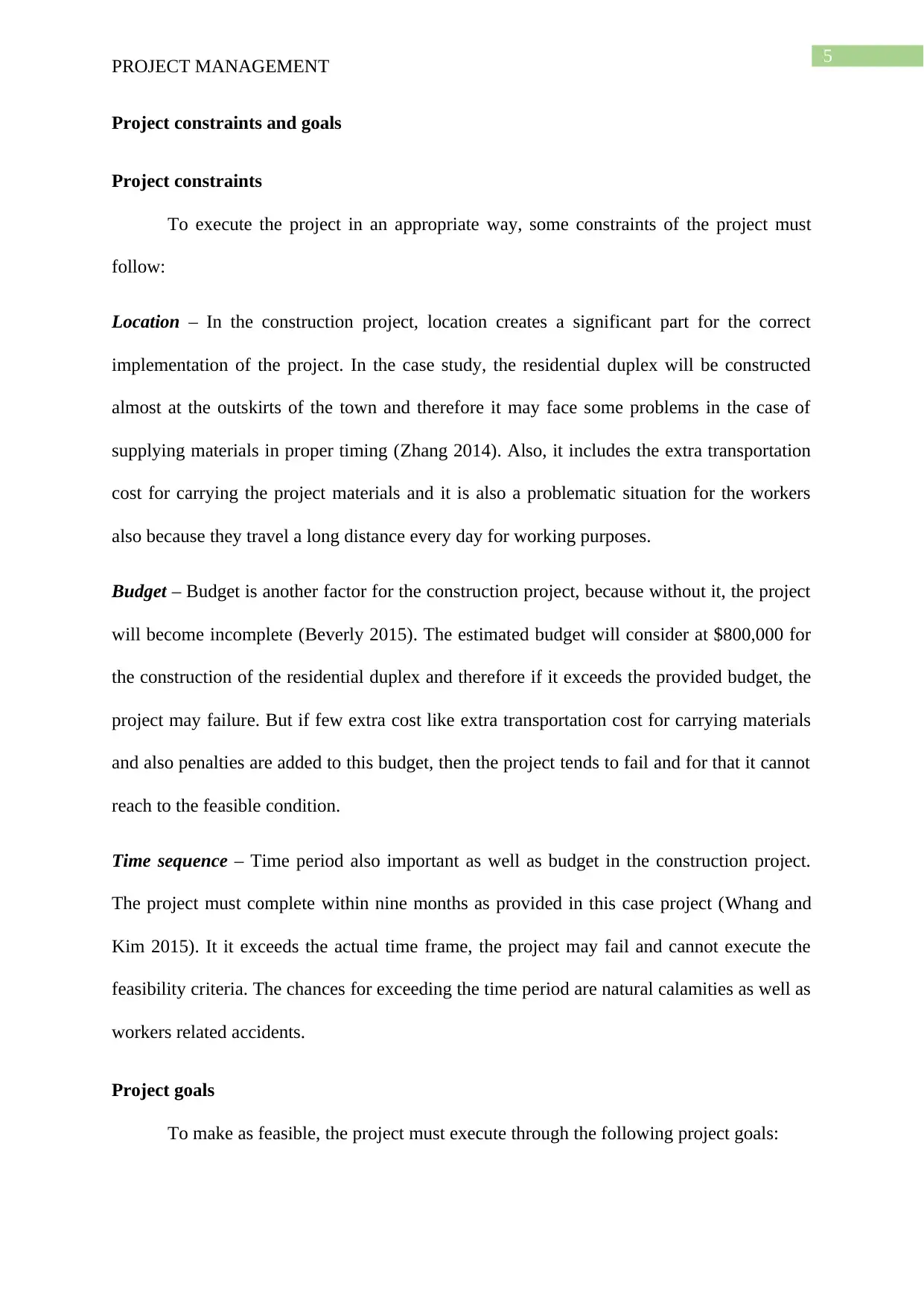
5
PROJECT MANAGEMENT
Project constraints and goals
Project constraints
To execute the project in an appropriate way, some constraints of the project must
follow:
Location – In the construction project, location creates a significant part for the correct
implementation of the project. In the case study, the residential duplex will be constructed
almost at the outskirts of the town and therefore it may face some problems in the case of
supplying materials in proper timing (Zhang 2014). Also, it includes the extra transportation
cost for carrying the project materials and it is also a problematic situation for the workers
also because they travel a long distance every day for working purposes.
Budget – Budget is another factor for the construction project, because without it, the project
will become incomplete (Beverly 2015). The estimated budget will consider at $800,000 for
the construction of the residential duplex and therefore if it exceeds the provided budget, the
project may failure. But if few extra cost like extra transportation cost for carrying materials
and also penalties are added to this budget, then the project tends to fail and for that it cannot
reach to the feasible condition.
Time sequence – Time period also important as well as budget in the construction project.
The project must complete within nine months as provided in this case project (Whang and
Kim 2015). It it exceeds the actual time frame, the project may fail and cannot execute the
feasibility criteria. The chances for exceeding the time period are natural calamities as well as
workers related accidents.
Project goals
To make as feasible, the project must execute through the following project goals:
PROJECT MANAGEMENT
Project constraints and goals
Project constraints
To execute the project in an appropriate way, some constraints of the project must
follow:
Location – In the construction project, location creates a significant part for the correct
implementation of the project. In the case study, the residential duplex will be constructed
almost at the outskirts of the town and therefore it may face some problems in the case of
supplying materials in proper timing (Zhang 2014). Also, it includes the extra transportation
cost for carrying the project materials and it is also a problematic situation for the workers
also because they travel a long distance every day for working purposes.
Budget – Budget is another factor for the construction project, because without it, the project
will become incomplete (Beverly 2015). The estimated budget will consider at $800,000 for
the construction of the residential duplex and therefore if it exceeds the provided budget, the
project may failure. But if few extra cost like extra transportation cost for carrying materials
and also penalties are added to this budget, then the project tends to fail and for that it cannot
reach to the feasible condition.
Time sequence – Time period also important as well as budget in the construction project.
The project must complete within nine months as provided in this case project (Whang and
Kim 2015). It it exceeds the actual time frame, the project may fail and cannot execute the
feasibility criteria. The chances for exceeding the time period are natural calamities as well as
workers related accidents.
Project goals
To make as feasible, the project must execute through the following project goals:
⊘ This is a preview!⊘
Do you want full access?
Subscribe today to unlock all pages.

Trusted by 1+ million students worldwide
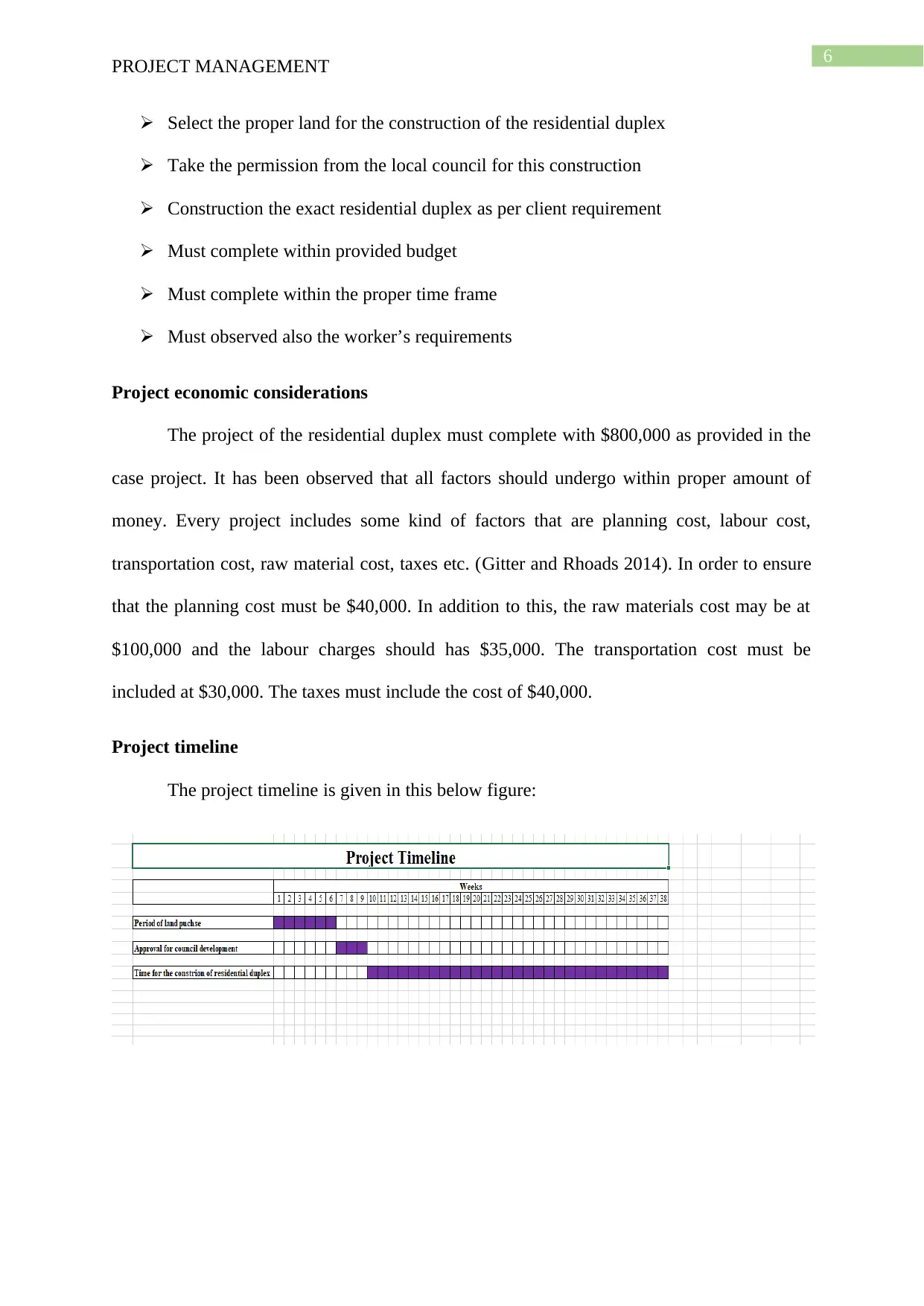
6
PROJECT MANAGEMENT
Select the proper land for the construction of the residential duplex
Take the permission from the local council for this construction
Construction the exact residential duplex as per client requirement
Must complete within provided budget
Must complete within the proper time frame
Must observed also the worker’s requirements
Project economic considerations
The project of the residential duplex must complete with $800,000 as provided in the
case project. It has been observed that all factors should undergo within proper amount of
money. Every project includes some kind of factors that are planning cost, labour cost,
transportation cost, raw material cost, taxes etc. (Gitter and Rhoads 2014). In order to ensure
that the planning cost must be $40,000. In addition to this, the raw materials cost may be at
$100,000 and the labour charges should has $35,000. The transportation cost must be
included at $30,000. The taxes must include the cost of $40,000.
Project timeline
The project timeline is given in this below figure:
PROJECT MANAGEMENT
Select the proper land for the construction of the residential duplex
Take the permission from the local council for this construction
Construction the exact residential duplex as per client requirement
Must complete within provided budget
Must complete within the proper time frame
Must observed also the worker’s requirements
Project economic considerations
The project of the residential duplex must complete with $800,000 as provided in the
case project. It has been observed that all factors should undergo within proper amount of
money. Every project includes some kind of factors that are planning cost, labour cost,
transportation cost, raw material cost, taxes etc. (Gitter and Rhoads 2014). In order to ensure
that the planning cost must be $40,000. In addition to this, the raw materials cost may be at
$100,000 and the labour charges should has $35,000. The transportation cost must be
included at $30,000. The taxes must include the cost of $40,000.
Project timeline
The project timeline is given in this below figure:
Paraphrase This Document
Need a fresh take? Get an instant paraphrase of this document with our AI Paraphraser
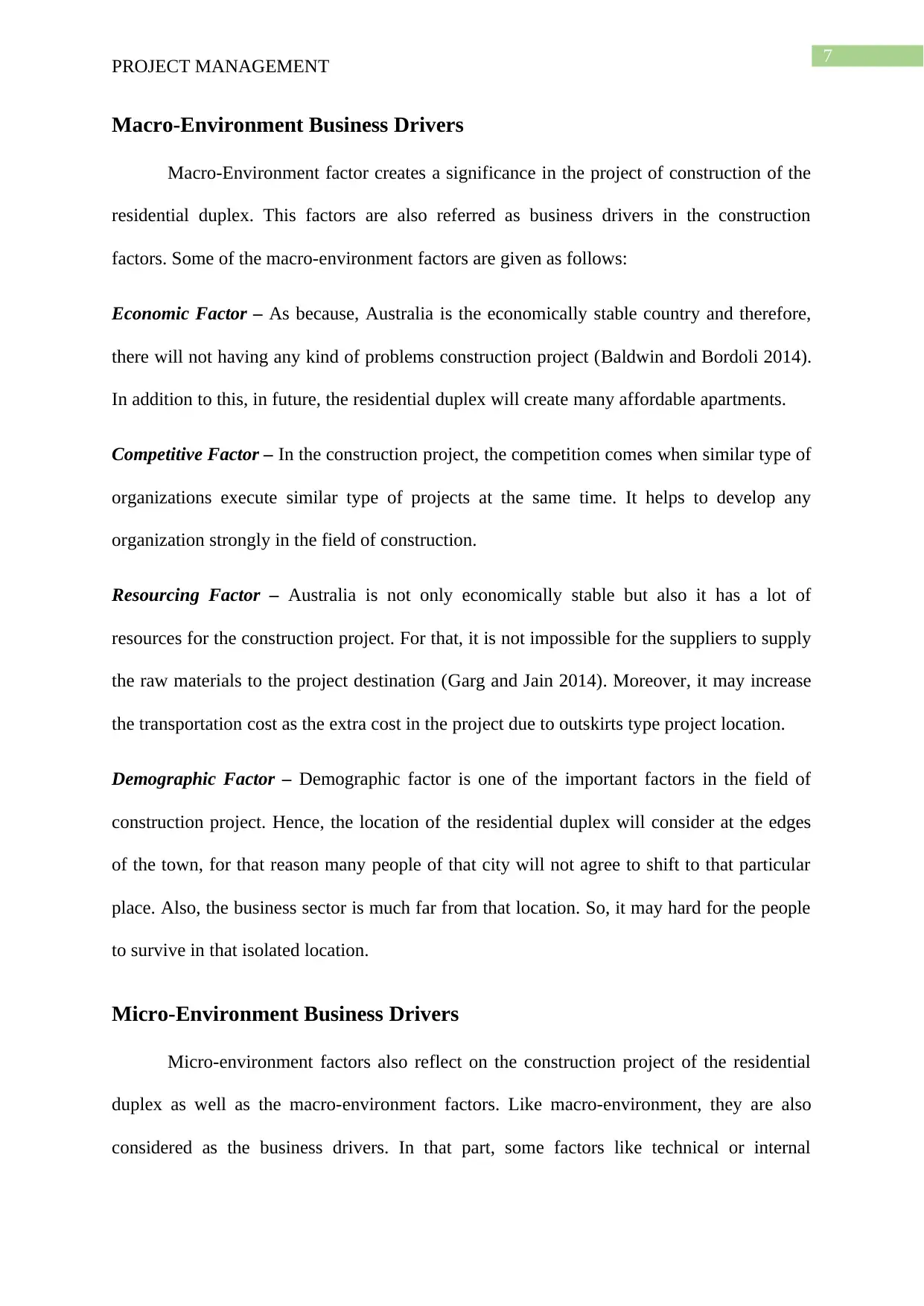
7
PROJECT MANAGEMENT
Macro-Environment Business Drivers
Macro-Environment factor creates a significance in the project of construction of the
residential duplex. This factors are also referred as business drivers in the construction
factors. Some of the macro-environment factors are given as follows:
Economic Factor – As because, Australia is the economically stable country and therefore,
there will not having any kind of problems construction project (Baldwin and Bordoli 2014).
In addition to this, in future, the residential duplex will create many affordable apartments.
Competitive Factor – In the construction project, the competition comes when similar type of
organizations execute similar type of projects at the same time. It helps to develop any
organization strongly in the field of construction.
Resourcing Factor – Australia is not only economically stable but also it has a lot of
resources for the construction project. For that, it is not impossible for the suppliers to supply
the raw materials to the project destination (Garg and Jain 2014). Moreover, it may increase
the transportation cost as the extra cost in the project due to outskirts type project location.
Demographic Factor – Demographic factor is one of the important factors in the field of
construction project. Hence, the location of the residential duplex will consider at the edges
of the town, for that reason many people of that city will not agree to shift to that particular
place. Also, the business sector is much far from that location. So, it may hard for the people
to survive in that isolated location.
Micro-Environment Business Drivers
Micro-environment factors also reflect on the construction project of the residential
duplex as well as the macro-environment factors. Like macro-environment, they are also
considered as the business drivers. In that part, some factors like technical or internal
PROJECT MANAGEMENT
Macro-Environment Business Drivers
Macro-Environment factor creates a significance in the project of construction of the
residential duplex. This factors are also referred as business drivers in the construction
factors. Some of the macro-environment factors are given as follows:
Economic Factor – As because, Australia is the economically stable country and therefore,
there will not having any kind of problems construction project (Baldwin and Bordoli 2014).
In addition to this, in future, the residential duplex will create many affordable apartments.
Competitive Factor – In the construction project, the competition comes when similar type of
organizations execute similar type of projects at the same time. It helps to develop any
organization strongly in the field of construction.
Resourcing Factor – Australia is not only economically stable but also it has a lot of
resources for the construction project. For that, it is not impossible for the suppliers to supply
the raw materials to the project destination (Garg and Jain 2014). Moreover, it may increase
the transportation cost as the extra cost in the project due to outskirts type project location.
Demographic Factor – Demographic factor is one of the important factors in the field of
construction project. Hence, the location of the residential duplex will consider at the edges
of the town, for that reason many people of that city will not agree to shift to that particular
place. Also, the business sector is much far from that location. So, it may hard for the people
to survive in that isolated location.
Micro-Environment Business Drivers
Micro-environment factors also reflect on the construction project of the residential
duplex as well as the macro-environment factors. Like macro-environment, they are also
considered as the business drivers. In that part, some factors like technical or internal
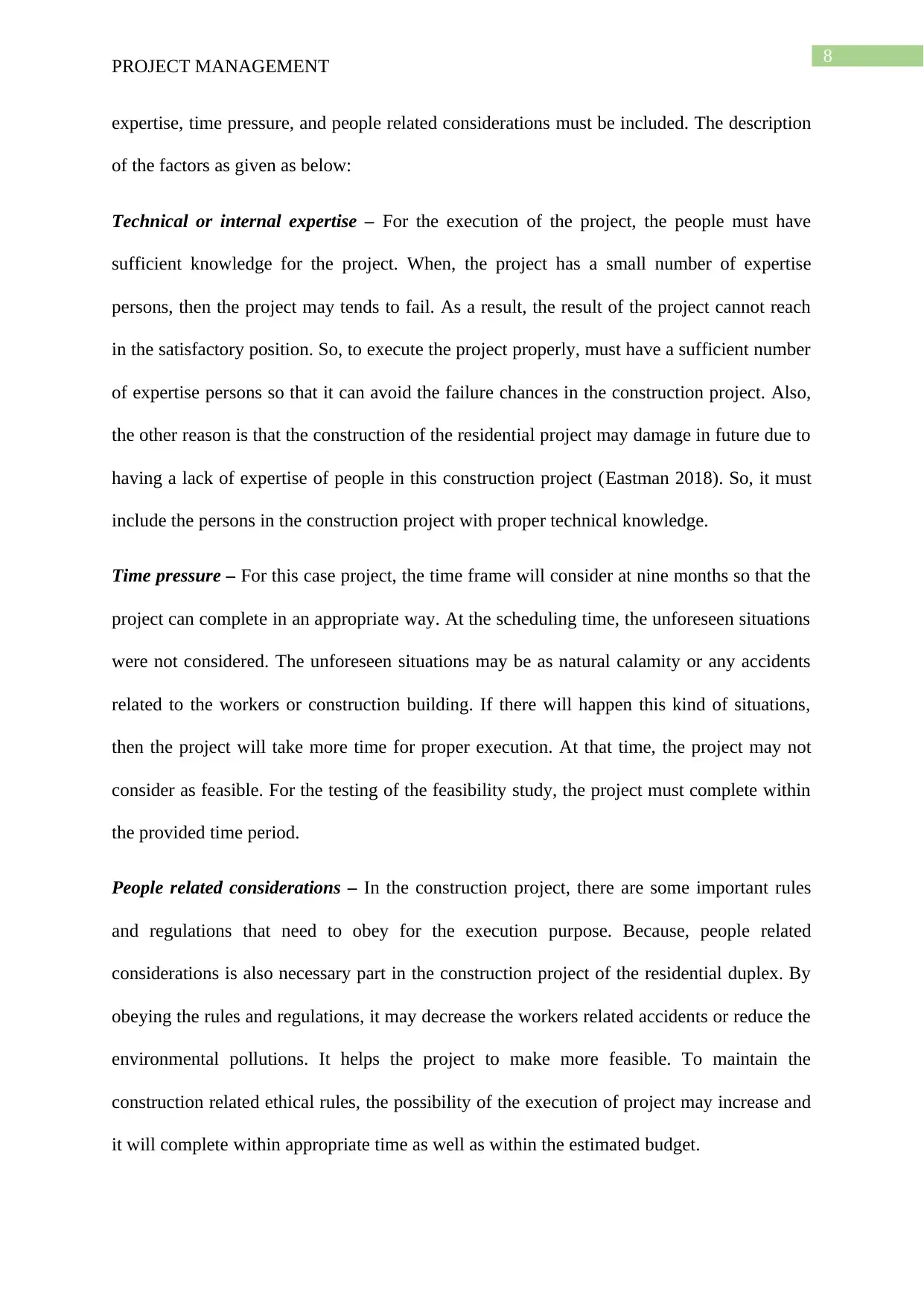
8
PROJECT MANAGEMENT
expertise, time pressure, and people related considerations must be included. The description
of the factors as given as below:
Technical or internal expertise – For the execution of the project, the people must have
sufficient knowledge for the project. When, the project has a small number of expertise
persons, then the project may tends to fail. As a result, the result of the project cannot reach
in the satisfactory position. So, to execute the project properly, must have a sufficient number
of expertise persons so that it can avoid the failure chances in the construction project. Also,
the other reason is that the construction of the residential project may damage in future due to
having a lack of expertise of people in this construction project (Eastman 2018). So, it must
include the persons in the construction project with proper technical knowledge.
Time pressure – For this case project, the time frame will consider at nine months so that the
project can complete in an appropriate way. At the scheduling time, the unforeseen situations
were not considered. The unforeseen situations may be as natural calamity or any accidents
related to the workers or construction building. If there will happen this kind of situations,
then the project will take more time for proper execution. At that time, the project may not
consider as feasible. For the testing of the feasibility study, the project must complete within
the provided time period.
People related considerations – In the construction project, there are some important rules
and regulations that need to obey for the execution purpose. Because, people related
considerations is also necessary part in the construction project of the residential duplex. By
obeying the rules and regulations, it may decrease the workers related accidents or reduce the
environmental pollutions. It helps the project to make more feasible. To maintain the
construction related ethical rules, the possibility of the execution of project may increase and
it will complete within appropriate time as well as within the estimated budget.
PROJECT MANAGEMENT
expertise, time pressure, and people related considerations must be included. The description
of the factors as given as below:
Technical or internal expertise – For the execution of the project, the people must have
sufficient knowledge for the project. When, the project has a small number of expertise
persons, then the project may tends to fail. As a result, the result of the project cannot reach
in the satisfactory position. So, to execute the project properly, must have a sufficient number
of expertise persons so that it can avoid the failure chances in the construction project. Also,
the other reason is that the construction of the residential project may damage in future due to
having a lack of expertise of people in this construction project (Eastman 2018). So, it must
include the persons in the construction project with proper technical knowledge.
Time pressure – For this case project, the time frame will consider at nine months so that the
project can complete in an appropriate way. At the scheduling time, the unforeseen situations
were not considered. The unforeseen situations may be as natural calamity or any accidents
related to the workers or construction building. If there will happen this kind of situations,
then the project will take more time for proper execution. At that time, the project may not
consider as feasible. For the testing of the feasibility study, the project must complete within
the provided time period.
People related considerations – In the construction project, there are some important rules
and regulations that need to obey for the execution purpose. Because, people related
considerations is also necessary part in the construction project of the residential duplex. By
obeying the rules and regulations, it may decrease the workers related accidents or reduce the
environmental pollutions. It helps the project to make more feasible. To maintain the
construction related ethical rules, the possibility of the execution of project may increase and
it will complete within appropriate time as well as within the estimated budget.
⊘ This is a preview!⊘
Do you want full access?
Subscribe today to unlock all pages.

Trusted by 1+ million students worldwide
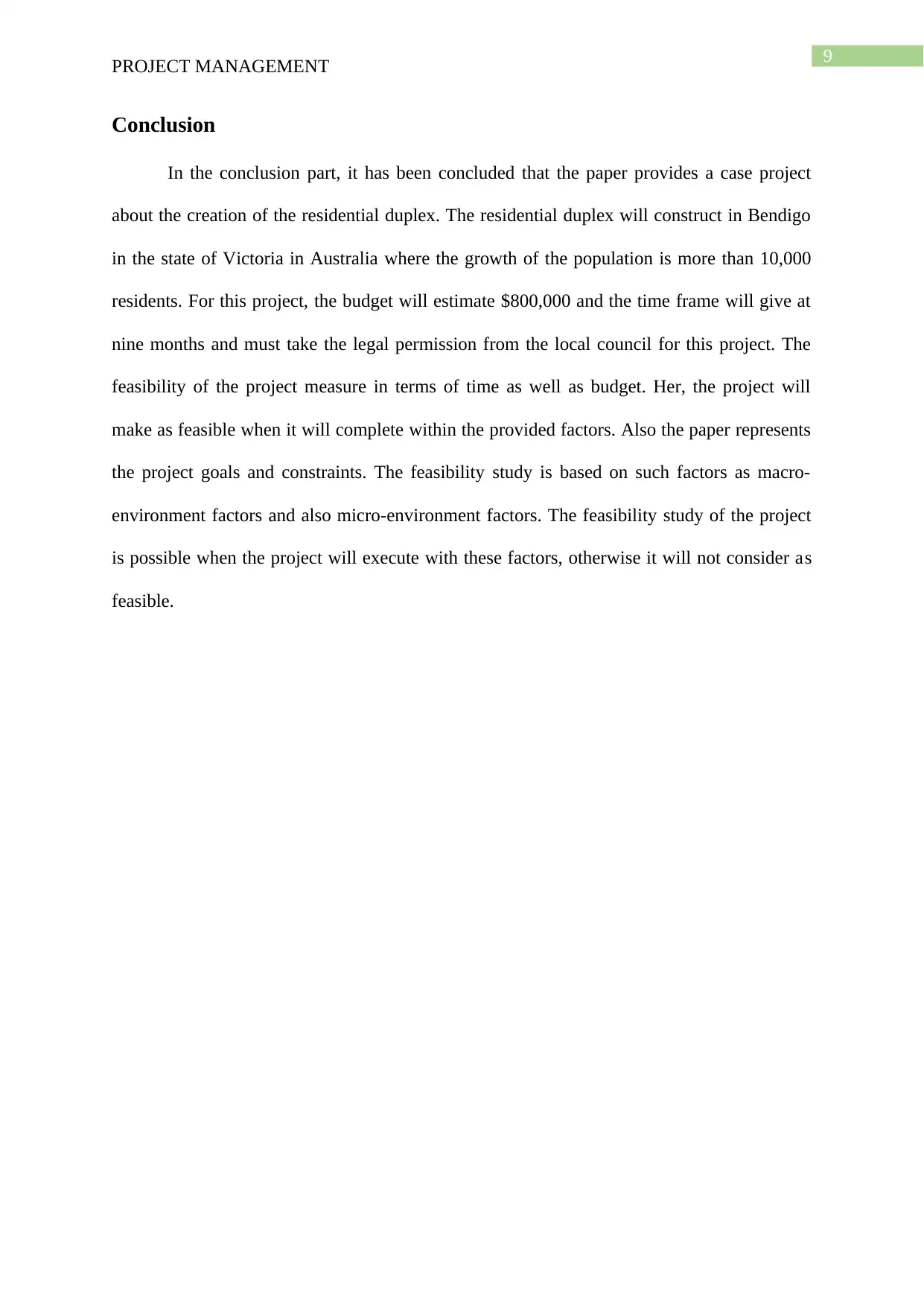
9
PROJECT MANAGEMENT
Conclusion
In the conclusion part, it has been concluded that the paper provides a case project
about the creation of the residential duplex. The residential duplex will construct in Bendigo
in the state of Victoria in Australia where the growth of the population is more than 10,000
residents. For this project, the budget will estimate $800,000 and the time frame will give at
nine months and must take the legal permission from the local council for this project. The
feasibility of the project measure in terms of time as well as budget. Her, the project will
make as feasible when it will complete within the provided factors. Also the paper represents
the project goals and constraints. The feasibility study is based on such factors as macro-
environment factors and also micro-environment factors. The feasibility study of the project
is possible when the project will execute with these factors, otherwise it will not consider as
feasible.
PROJECT MANAGEMENT
Conclusion
In the conclusion part, it has been concluded that the paper provides a case project
about the creation of the residential duplex. The residential duplex will construct in Bendigo
in the state of Victoria in Australia where the growth of the population is more than 10,000
residents. For this project, the budget will estimate $800,000 and the time frame will give at
nine months and must take the legal permission from the local council for this project. The
feasibility of the project measure in terms of time as well as budget. Her, the project will
make as feasible when it will complete within the provided factors. Also the paper represents
the project goals and constraints. The feasibility study is based on such factors as macro-
environment factors and also micro-environment factors. The feasibility study of the project
is possible when the project will execute with these factors, otherwise it will not consider as
feasible.
Paraphrase This Document
Need a fresh take? Get an instant paraphrase of this document with our AI Paraphraser
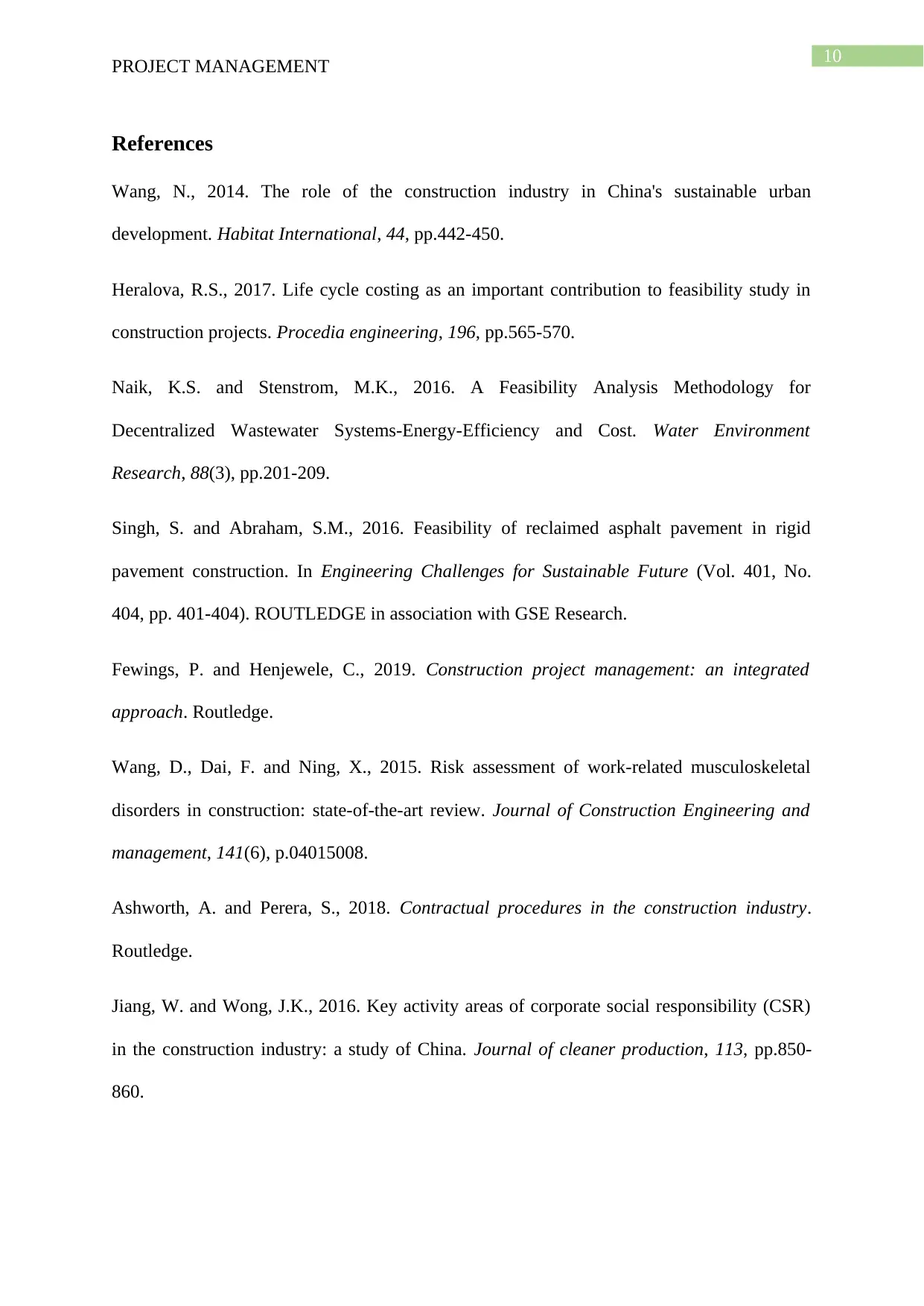
10
PROJECT MANAGEMENT
References
Wang, N., 2014. The role of the construction industry in China's sustainable urban
development. Habitat International, 44, pp.442-450.
Heralova, R.S., 2017. Life cycle costing as an important contribution to feasibility study in
construction projects. Procedia engineering, 196, pp.565-570.
Naik, K.S. and Stenstrom, M.K., 2016. A Feasibility Analysis Methodology for
Decentralized Wastewater Systems‐Energy-Efficiency and Cost. Water Environment
Research, 88(3), pp.201-209.
Singh, S. and Abraham, S.M., 2016. Feasibility of reclaimed asphalt pavement in rigid
pavement construction. In Engineering Challenges for Sustainable Future (Vol. 401, No.
404, pp. 401-404). ROUTLEDGE in association with GSE Research.
Fewings, P. and Henjewele, C., 2019. Construction project management: an integrated
approach. Routledge.
Wang, D., Dai, F. and Ning, X., 2015. Risk assessment of work-related musculoskeletal
disorders in construction: state-of-the-art review. Journal of Construction Engineering and
management, 141(6), p.04015008.
Ashworth, A. and Perera, S., 2018. Contractual procedures in the construction industry.
Routledge.
Jiang, W. and Wong, J.K., 2016. Key activity areas of corporate social responsibility (CSR)
in the construction industry: a study of China. Journal of cleaner production, 113, pp.850-
860.
PROJECT MANAGEMENT
References
Wang, N., 2014. The role of the construction industry in China's sustainable urban
development. Habitat International, 44, pp.442-450.
Heralova, R.S., 2017. Life cycle costing as an important contribution to feasibility study in
construction projects. Procedia engineering, 196, pp.565-570.
Naik, K.S. and Stenstrom, M.K., 2016. A Feasibility Analysis Methodology for
Decentralized Wastewater Systems‐Energy-Efficiency and Cost. Water Environment
Research, 88(3), pp.201-209.
Singh, S. and Abraham, S.M., 2016. Feasibility of reclaimed asphalt pavement in rigid
pavement construction. In Engineering Challenges for Sustainable Future (Vol. 401, No.
404, pp. 401-404). ROUTLEDGE in association with GSE Research.
Fewings, P. and Henjewele, C., 2019. Construction project management: an integrated
approach. Routledge.
Wang, D., Dai, F. and Ning, X., 2015. Risk assessment of work-related musculoskeletal
disorders in construction: state-of-the-art review. Journal of Construction Engineering and
management, 141(6), p.04015008.
Ashworth, A. and Perera, S., 2018. Contractual procedures in the construction industry.
Routledge.
Jiang, W. and Wong, J.K., 2016. Key activity areas of corporate social responsibility (CSR)
in the construction industry: a study of China. Journal of cleaner production, 113, pp.850-
860.
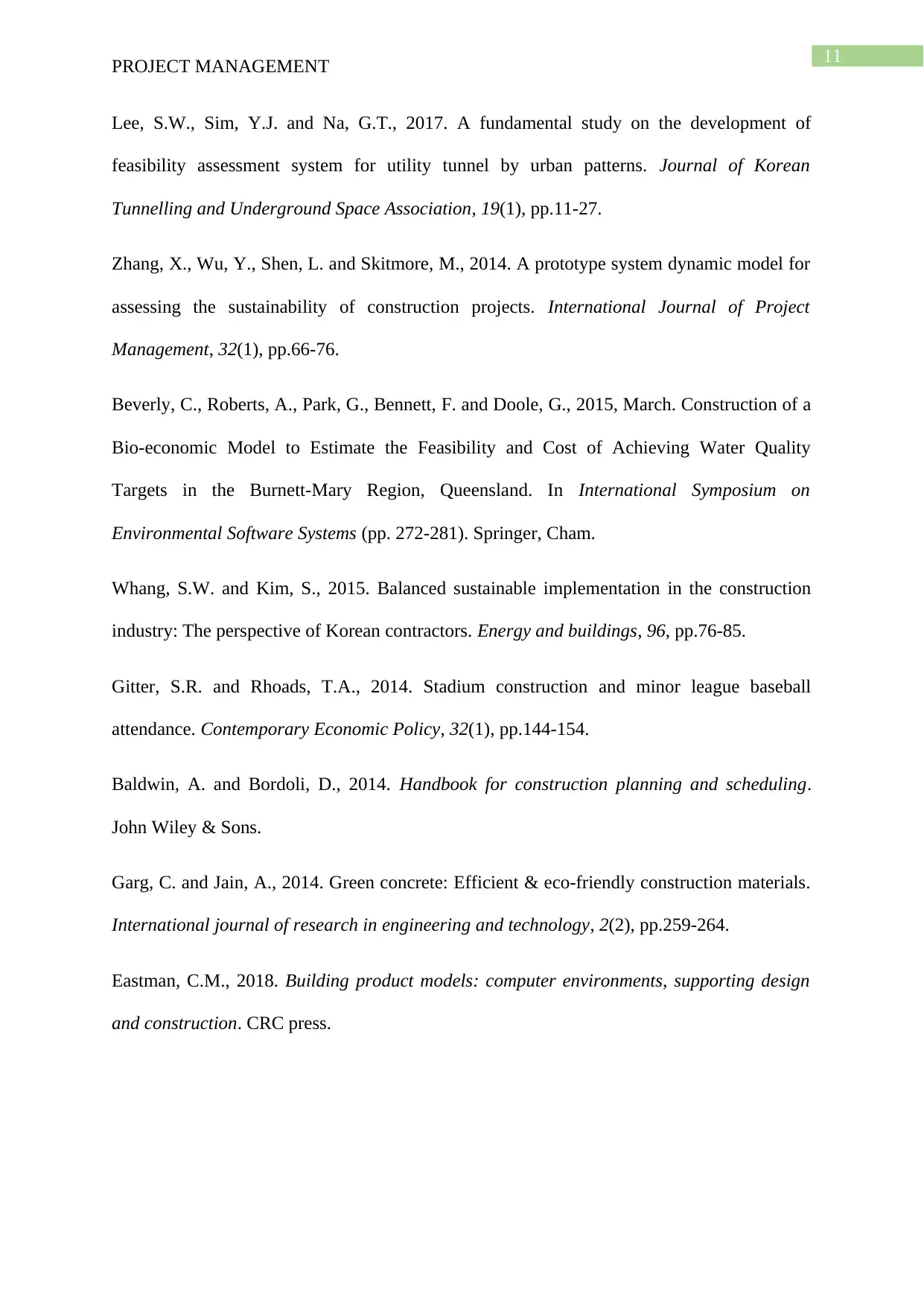
11
PROJECT MANAGEMENT
Lee, S.W., Sim, Y.J. and Na, G.T., 2017. A fundamental study on the development of
feasibility assessment system for utility tunnel by urban patterns. Journal of Korean
Tunnelling and Underground Space Association, 19(1), pp.11-27.
Zhang, X., Wu, Y., Shen, L. and Skitmore, M., 2014. A prototype system dynamic model for
assessing the sustainability of construction projects. International Journal of Project
Management, 32(1), pp.66-76.
Beverly, C., Roberts, A., Park, G., Bennett, F. and Doole, G., 2015, March. Construction of a
Bio-economic Model to Estimate the Feasibility and Cost of Achieving Water Quality
Targets in the Burnett-Mary Region, Queensland. In International Symposium on
Environmental Software Systems (pp. 272-281). Springer, Cham.
Whang, S.W. and Kim, S., 2015. Balanced sustainable implementation in the construction
industry: The perspective of Korean contractors. Energy and buildings, 96, pp.76-85.
Gitter, S.R. and Rhoads, T.A., 2014. Stadium construction and minor league baseball
attendance. Contemporary Economic Policy, 32(1), pp.144-154.
Baldwin, A. and Bordoli, D., 2014. Handbook for construction planning and scheduling.
John Wiley & Sons.
Garg, C. and Jain, A., 2014. Green concrete: Efficient & eco-friendly construction materials.
International journal of research in engineering and technology, 2(2), pp.259-264.
Eastman, C.M., 2018. Building product models: computer environments, supporting design
and construction. CRC press.
PROJECT MANAGEMENT
Lee, S.W., Sim, Y.J. and Na, G.T., 2017. A fundamental study on the development of
feasibility assessment system for utility tunnel by urban patterns. Journal of Korean
Tunnelling and Underground Space Association, 19(1), pp.11-27.
Zhang, X., Wu, Y., Shen, L. and Skitmore, M., 2014. A prototype system dynamic model for
assessing the sustainability of construction projects. International Journal of Project
Management, 32(1), pp.66-76.
Beverly, C., Roberts, A., Park, G., Bennett, F. and Doole, G., 2015, March. Construction of a
Bio-economic Model to Estimate the Feasibility and Cost of Achieving Water Quality
Targets in the Burnett-Mary Region, Queensland. In International Symposium on
Environmental Software Systems (pp. 272-281). Springer, Cham.
Whang, S.W. and Kim, S., 2015. Balanced sustainable implementation in the construction
industry: The perspective of Korean contractors. Energy and buildings, 96, pp.76-85.
Gitter, S.R. and Rhoads, T.A., 2014. Stadium construction and minor league baseball
attendance. Contemporary Economic Policy, 32(1), pp.144-154.
Baldwin, A. and Bordoli, D., 2014. Handbook for construction planning and scheduling.
John Wiley & Sons.
Garg, C. and Jain, A., 2014. Green concrete: Efficient & eco-friendly construction materials.
International journal of research in engineering and technology, 2(2), pp.259-264.
Eastman, C.M., 2018. Building product models: computer environments, supporting design
and construction. CRC press.
⊘ This is a preview!⊘
Do you want full access?
Subscribe today to unlock all pages.

Trusted by 1+ million students worldwide
1 out of 12
Related Documents
Your All-in-One AI-Powered Toolkit for Academic Success.
+13062052269
info@desklib.com
Available 24*7 on WhatsApp / Email
![[object Object]](/_next/static/media/star-bottom.7253800d.svg)
Unlock your academic potential
Copyright © 2020–2025 A2Z Services. All Rights Reserved. Developed and managed by ZUCOL.





